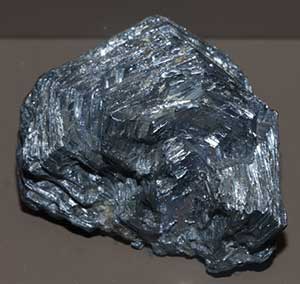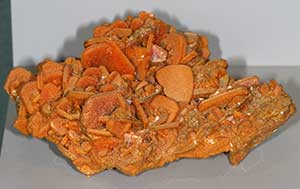 |
|
Molybdenite - MoS2.
|
 |
| Wulfenite - PbMoO4. |
Molybdenum is a refractory metallic element used principally as an alloying agent in cast iron, steel, and superalloys to enhance hardenability, strength, toughness, and wear and corrosion resistance. In the United States, molybdenum is mined and produced as a byproduct. Three plants converted molybdenite (MoS2) concentrate to molybdic oxide, from which such intermediate products as ferromolybdenum, metal powder, and various chemicals were produced. The United States is the world's largest producer of molybdenum.
Background
Molybdenum is a metallic, silvery-white element, with an atomic number of 42. Its chemical symbol is Mo. Chemically, it is very stable, but it will react with acids. The physical characteristic that makes molybdenum unique is that it has a very high melting point, 4,730 degrees Fahrenheit. This is 2,000 degrees higher than the melting point of steel. It is 1,000 degrees higher than the melting temperature of most rocks. It has the fifth highest melting point of all of the elements.Molybdenite (MoS2, molybdenum sulfide) is the major ore mineral for molybdenum (sometimes called moly for short). It is rarely found as crystals, but is commonly found as what mineralogists describe as foliated masses. This means the mineral forms folia or layers, like the mineral mica. It is metallic gray, has a greasy feel, and is very soft at only 1 on Moh's hardness scale. Its softness, metallic luster and gray color led scientists to mistakenly believe it was a lead mineral. Geologically, molybdenite forms in high-temperature environments such as in igneous rocks. Some molybdenite forms when igneous bodies contact rock and metamorphose, or change, the rock. This is called contact metamorphism.
Molybdenum is also found in the mineral wulfenite (Pb(MoO4), lead molybdate). Wulfenite forms colorful, bright orange, red, and yellow crystals. They can be blocky or so thin that they are transparent. The two drawings here illustrate these two mineral habits. (Habit is a description of the form in which a particular mineral has grown.)
Molybdenum is a needed element in plants and animals. In plants, for example, the presence of molybdenum in certain enzymes allows the plant to absorb nitrogen. Soil that has no molybdenum at all cannot support plant life.
Molybdenum was discovered by the Swedish scientist, Peter Hjelm in 1781, three years after Carl Scheele proposed that a previously unknown element could be found in the mineral molybdenite.
Name
In 1778, Swedish chemist Carl William Scheele was studying, what he thought was lead, in the mineral molybdenite. Molybdenite was named after the Greek word molybdos, which means lead. Sheele's studies led him to the conclusion that this mineral did not contain lead, but some other element. He named this new element molybdenum after the mineral molybdenite. (As an aside, the mineral scheelite (Ca(WO4,MoO4), calcium tungstate-molybdate) was named after Scheele in honor of his discovery of molybdenum.)
Sources
The most important ore source of molybdenum is the mineral molybdenite. A minor amount is recovered from the mineral wulfenite. Some molybdenum is also recovered as a by-product or co-product from copper mining.
The United States produces significant quantities of molybdenite from mines in Colorado, New Mexico, and Idaho. Other mines in Arizona, New Mexico, Montana, and Utah produce molybdenum as a by-product. The largest molybdenum resource in the U.S. is in Climax, Colorado. It is estimated that there are 5.5 million metric tons of molybdenum in the United States. It is probable there are more molybdenum resources in the U.S. yet to be discovered.
There are significant molybdenum resources around the world. The leading producers are Canada, China, Chile, Mexico, Peru, Russia and Mongolia. It is estimated that there are 12 million metric tons of molybdenum in the world. Other ore deposits may be discovered.
Uses
Molybdenum is alloyed with steel making it stronger and more highly resistant to heat because molybdenum has such a high melting temperature. The alloys are used to make such things as rifle barrels and filaments for light bulbs. The iron and steel industries account for more than 75% of molybdenum consumption.
The two largest uses of molybdenum are as an alloy in stainless steels and in alloy steels-these two uses consume about 60% of the molybdenum needs in the United States. Stainless steels include the strength and corrosion-resistant requirements for water distribution systems, food handling equipment, chemical processing equipment, home, hospital, and laboratory requirements. Alloy steels include the stronger and tougher steels needed to make automotive parts, construction equipment, gas transmission pipes.
Other major uses as an alloy include: Tool steels, for things like bearings, dies, machining components; cast irons, for steel mill rolls, auto parts, crusher parts; super alloys for use in furnace parts, gas turbine parts, chemical processing equipment.
Molybdenum also is an important material for the chemicals and lubricant industries. Molybdenum has uses as catalysts, paint pigments, corrosion inhibitors, smoke and flame retardants, dry lubricant (molybdenum disulfide) on space vehicles and resistant to high loads and temperatures. As a pure metal, molybdenum is used because of its high melting temperatures (4,730 F.) as filament supports in light bulbs, metal-working dies and furnace parts. Molybdenum cathodes are used in special electrical applications. It can also be used as a catalyst in some chemical applications.
General uses for molybdenum are in machinery (35%), for electrical applications (15%), in transportation (15%), in chemicals (10%), in the oil and gas industry (10%), and assorted others (15%).
Substitutes and Alternative Sources
Possible substitutes for molybdenum as a strengthening alloy in steel include vanadium, chromium, columbium, and boron. However, such substitution is not presently practiced since molybdenum is plentiful, affordable, and effective.